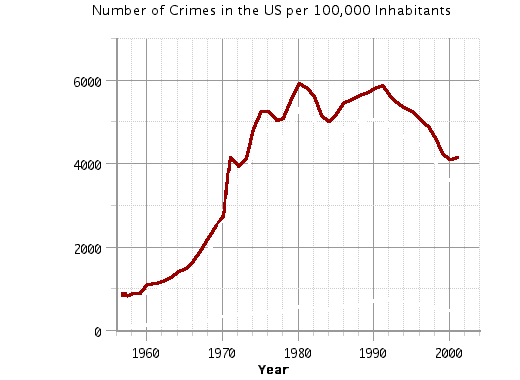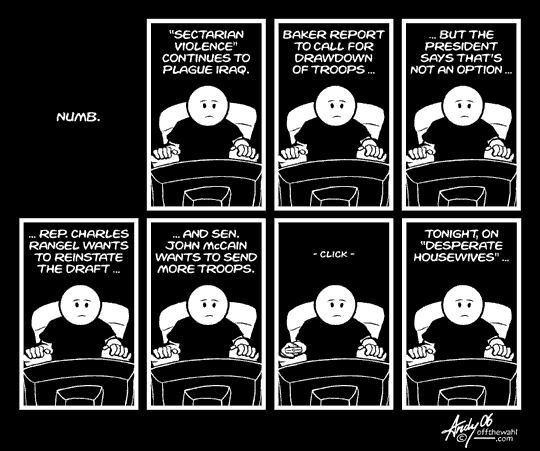|
||||
|
|
|
|||
| Home | Subscribe | Back Issues | The Organization | Volunteer | Do Something | ||||
|
||||
|
War Abroad, Crime at Home by Doug Collins
Much mainstream media attention has been shed on the rise in crime rates across the US, after a decade of gradual decline. I've long been suspecting this would happen. During the US involvement in the Vietnam War from 1956 to 1975, crime rates skyrocketed in the US, roughly quadrupling (see graph). After that war was over, crime rates increased more slowly, stabilized, then started to slowly drop. In recent years, crime rates have gradually subsided to about the same level as near the end of the Vietnam War, still high by historical standards. Now it seems they are on the rise again. If this rise in crime is related to the war, then how? At first I incorrectly assumed that an increase in crime during wartime would be due to shell-shocked war veterans who return to the US desensitized to violence and living their lives on a reactive hair trigger. That's not likely. In fact, a year 2000 study by the Justice Department's Bureau of Statistics showed that military veterans were less than 50% as likely to be convicted of crimes as non-veterans. (www.ojp.usdoj.gov/bjs/pub/press/vpj.pr ) The problem with crime, then, seems to be more with the general population. Because no plausible direct relation between soldiering and the Vietnam-era crime wave has been found, various historians and analysts have cited other factors that may have contributed in the 1960s. Most commonly cited is the serious racial tensions that existed that decade. But I would guess that racially-motivated violence was a tiny--though well-publicized--portion of total crime at that time, and was not likely to skew crime rates up greatly. You might think that a bad economy or unemployment would cause a rise in crime, but the economy was booming in the 1960s and jobs were plentiful. Around 1980, social scientists began to find a strong correlation between rising rates of drug addiction and rising crime rates. But few researchers then or now have brought up the connection between addictive drugs and the wars America fights. As probably most Vietnam vets can tell you, underground commerce during that war greatly increased the channels for heroin trade to the United States. If Oliver North would talk, he'd certainly tell us a lot about the Reagan-era cocaine trade resulting from our Latin American military involvement. Nowadays, highly potent Afghani heroin is making inroads into the US. The history of US military involvement since the 1960s seems to often pave the way for the drug trade. Drugs are, however, only one factor that could raise crime rates as a result of war. Consider also the obvious. Big national spending on a war effort results in less funding for many social services, including basic policing. In scores of localities around the US and the UK, local police are getting budget cuts or being re-assigned to anti-terrorism duties (like guarding landmarks), or both. This means less community policing. Pre-Katrina budget requests for bolstering the New Orleans water defense system were ignored in favor of funding for post-9/11 War On Terrorism. It's clear that a miasm of crime has developed as a result of that. Wartime budget cuts also probably tend to eliminate antipoverty programs and drug-treatment programs, which might provide buffers against rising crime rates. We shouldn't ignore larger-picture effects of war on our culture. During war, killing the "enemy" is widely regarded as justifiable, and people may as a result be more willing to harm personal adversaries in everyday life.
In terms of technology, another war-related reason for crime increases might be our modern electronic entertainment. Military psychologist Col. David Grossman has noticed similarities between modern video games and combat conditioning in military basic training: "...with the advent of interactive 'point-and-shoot' arcade and video games there is significant concern that society is aping military conditioning without the vital safeguard of discipline. There is strong evidence to indicate that the indiscriminate civilian application of combat conditioning techniques as entertainment [i.e. violent video games] may be a key factor in worldwide, skyrocketing violent crime rates, including a sevenfold increase in per capita aggravated assaults in America since 1956." Grossman's fascinating exploration of this and related topics appears in his book, Stop Teaching Our Kids to Kill. Grossman points out that the US is not alone in violent crime increases. Similar increases have been occurring in all countries: "Anywhere that American violent media appear, 15 years later, the murder rate has at least doubled." ( see www.schillerinstitute.org/new_viol/ctte_grossman.html ). Grossman's views are compelling, especially because he points out that modern crime waves are an international phenomenon. But he does not explain the gradual decline in violence in the US during the 1990s, a time when violent arcade games were becoming more common. Although there are mountains of documentation that media violence can predispose kids to violence--including a 1972 US Surgeon General's Report--it's also clear that media violence cannot be the only factor in a nation's violent crime rate. Grossman's analysis also doesn't explain why property crimes have risen and fallen in fairly close proportion to violent crimes throughout the last fifty years. However, given that television viewing is the highest in the US and UK--there's an average of four hours of television watched per person per day in both countries according to NationMaster.com--the fact that these two countries are the leaders of the "Coalition of the Willing" that initiated the Iraq War would seem to bolster Grossman's views.*
|
|


